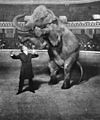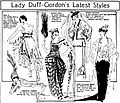Vaudeville facts for kids
A Vaudeville was a fun type of entertainment that changed over time. It started in France as a song or poem that made fun of things, especially in the 17th and 18th centuries. These songs were often part of French theatre shows.
Later, in the late 1800s, the word "vaudeville" was used for a very popular type of variety show in American theaters. These shows were big from the 1880s to the 1930s. An American vaudeville show usually had many different acts, like singers, dancers, comedians, and magicians, all in one performance. Performers would travel from town to town on what was called a "vaudeville circuit." Vaudeville became less popular when movies, cinema, and radio became the main ways people entertained themselves.
Contents
The Start of Vaudeville
The very first type of vaudeville was a song from Normandy, France, in the 15th century. It was called the vau de vire, named after a valley called Vire.
In the 16th century, another style of song became popular in French towns. These were called voix de ville, which means "city voices." These songs also made fun of things, just like the vau de vire.
Over time, these two styles of songs mixed together. By the 17th and 18th centuries, the word 'vaudeville' was used for songs that made fun of political events and things happening at the royal court. This meant they joked about leaders and important people.
How Vaudeville Shows Grew
The French "comédie en vaudeville" shows grew from these simple, funny songs. People in Paris in the late 1600s and early 1700s loved hearing new words put to tunes they already knew. These funny plays eventually turned into something called opéra-comique, which is a type of opera with spoken parts and songs.
The American Vaudeville Era
In America, vaudeville became a huge part of entertainment. It was like a live talent show with many different acts. You might see a singer, then a comedian, then an animal act, and then a magician, all in the same show!
Performers would travel around the country, going from one theater to another. This was called being on the "vaudeville circuit." It was a very exciting time for live entertainment before movies and radio became common.
Images for kids
-
From newspaper promotional for vaudeville character actor Charles Grapewin, circa 1900
-
Typical provincial venue on the circuit: "The Opera" in Kirksville, Missouri
-
Harry Houdini and Jennie, the Vanishing Elephant, January 7, 1918
-
Styles of Lucy, Lady Duff-Gordon, as presented in a vaudeville circuit pantomime and sketched by Marguerite Martyn of the St. Louis Post-Dispatch in April 1918
-
As the genre declined, most performers left the theatre. The child tap dancer Ray Wollbrinck, once called "the cleverest buckdancer on the vaudeville stage", later became a bandleader and ended his days as a bank teller.
See also
 In Spanish: Vodevil para niños
In Spanish: Vodevil para niños








